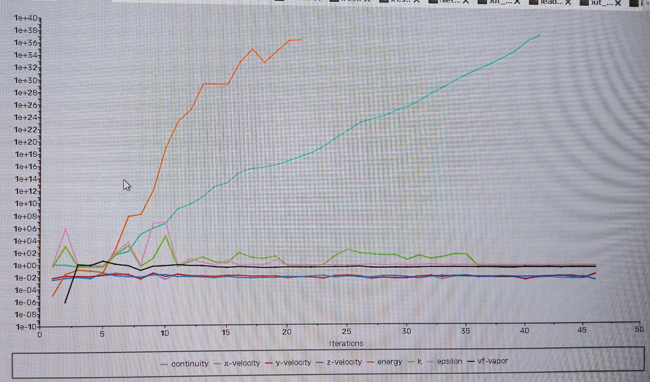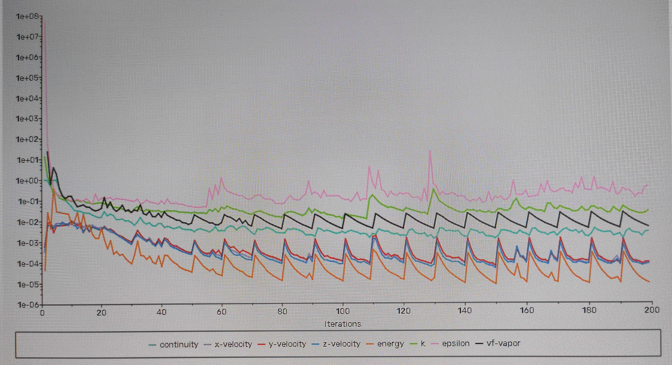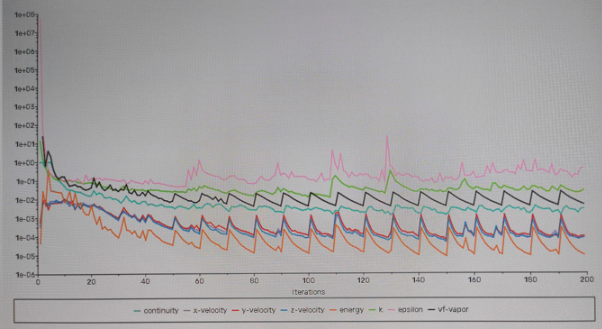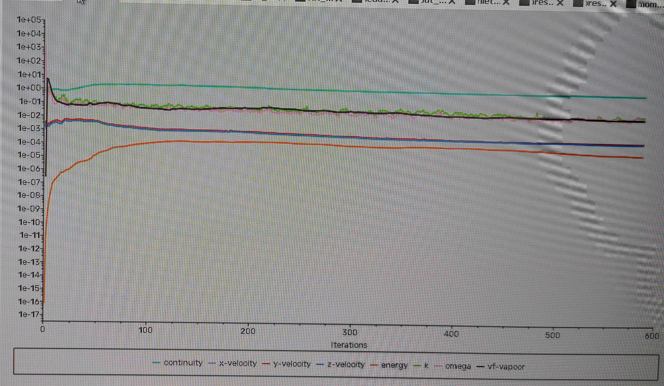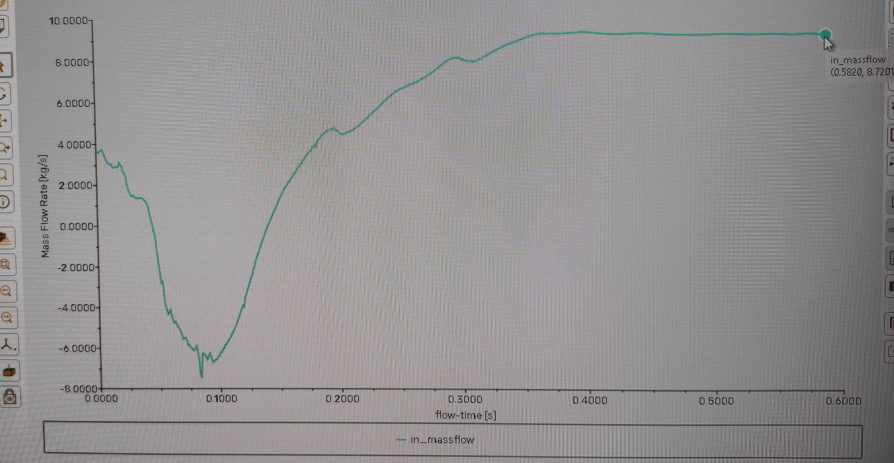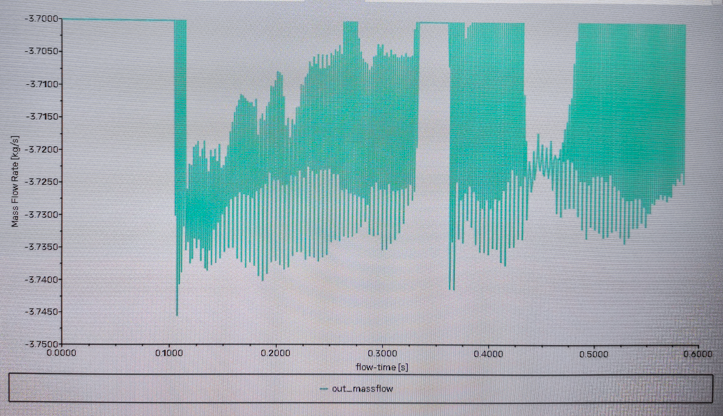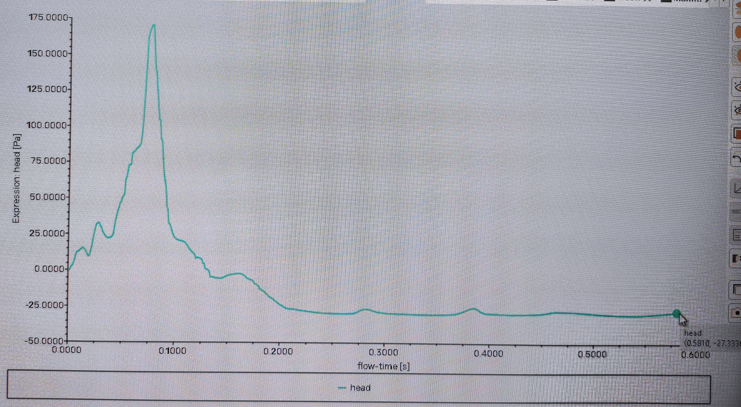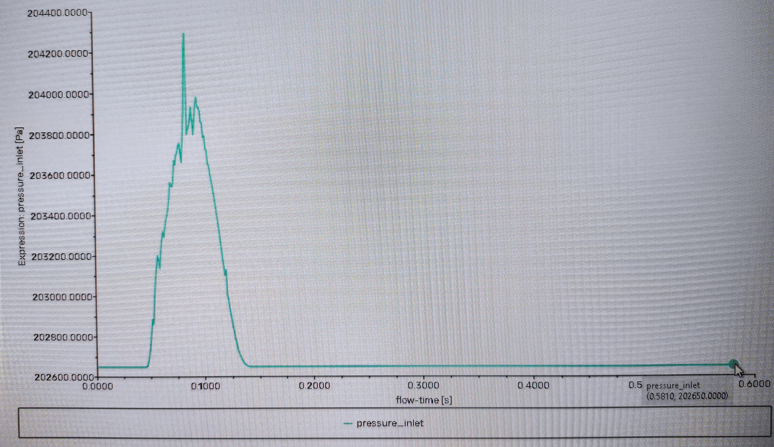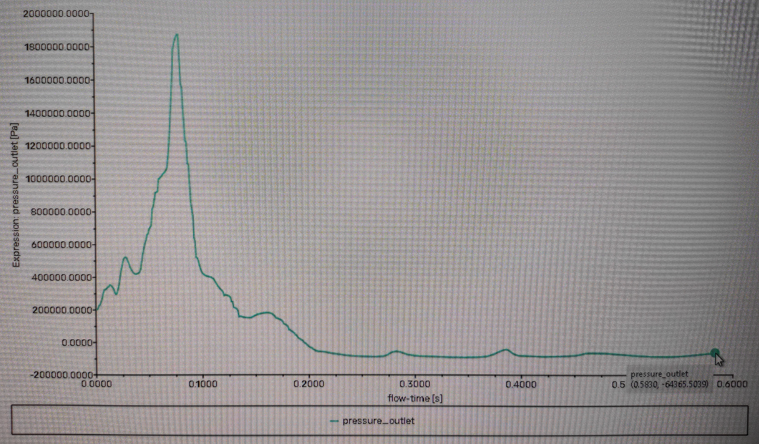-
-
December 30, 2023 at 5:04 pm
javat33489
SubscriberHi all.I am simulating the operation of a centrifugal pump.I did the calculations on the water, everything is fine.Previously, I saw a tutorial on HOW TO from ANSYS:https://www.youtube.com/embed/bgdBrOBuNgQand my settings are also the same, inlet pressure and outlet mass flow.Next, I need to calculate cavitation, I also paid attention to the video from ANSYS:My settings are the same again.My problem is that the calculation starts and the energy and continuity grow greatly, which leads to an error:I tried all the settings but nothing helps (changed methods, reduced relaxation coefficients, switched to stationary mode + pseudo transient, changed turbulence options k-e, k-omega, etc.).I used substep time steps of 0.001, it seems that this is not enough. I made a new calculation with a step of 1e-5, it was very long and left it to be decided further, the graph is already like this:Can this help? Should you take an even smaller step? The calculation will take even longer, I'm using 48 cores.Thank you. -
January 2, 2024 at 3:55 pm
Rob
Forum ModeratorHow many cells are in the model? Dropping much below 50-100k cells per core tends to reduce parallel efficiency.
You're aiming for a time step that means that the interface between zones move less than one cell per time step. Also that you have a small enough time step to resolve the transient behaviour.
-
January 2, 2024 at 4:44 pm
javat33489
SubscriberI have 7.5 million cells.
The graph that was obtained by decreasing the time corresponds to substep 1e-5. This is fine?
-
-
January 2, 2024 at 4:59 pm
Rob
Forum ModeratorI don't know, does the solver converge in 10-15 iterations?
-
January 2, 2024 at 5:08 pm
javat33489
SubscriberThere is convergence but it is bad, is there any point in continuing to reduce the substep to 1e-6?
-
-
January 2, 2024 at 5:46 pm
Rob
Forum ModeratorIf the convergence is bad you need to fix that, otherwise it's possible the results won't be of much use.
-
January 2, 2024 at 5:49 pm
javat33489
SubscriberAs can be seen from the graph, only epsilon converges poorly. That's why I asked, is it worth making the step smaller?
-
-
January 3, 2024 at 10:20 am
Rob
Forum ModeratorMaybe, if you compare results from the smaller timestep having run enough time for the solution to reach an equilibrium of some sort how do they compare with the larger timestep? Just looking at residuals isn't enough to determine if a solution is converged, you need to review the flowfield too. Are you using the results to design a prototype, justify a design change or just understand roughly what's going on in the casing? Do you need to defend the results for an MPhil, PhD, BEng etc?
-
January 3, 2024 at 4:14 pm
javat33489
Subscriber>>just understand roughly what's going on in the casing
YES
>>ou need to review the flowfield too
In this case, the flow curve evens out with the passage of time (at step 1e-5), I was scared by the epsilon curve, is it worth giving it a strong meaning?
-
-
January 3, 2024 at 4:31 pm
Rob
Forum ModeratorIf that's the case do you really need cavitation? Or can you just monitor pressure and infer cavitation?
Re the residual. It depends. I can't say the results are OK, but how useful they are will depend on why the convergence is poor. I've used results with "high" residuals before, but I also understand (and can explain) the consequences of using them backed up by images and other data. As I'm unable to review your model in detail I have to err on the side of caution. Ultimately it's your work, which you have to defend, so what do you think about the results? Ie the whole result, not just a couple of numbers in the residual plot.
CFD engineers need to be trained in both practical fluids and solver theory but also learn how to think about what's going on. Hence staff helping on here.
-
January 9, 2024 at 6:49 pm
javat33489
Subscribersir, earlier I showed you this graph and said that when the step was reduced to 1e-5, the growth of energy and continuity stopped. But no. After many iterations, the energy and continuity begins to grow strongly and I don’t know the reason.Let me remind you that I am calculating a centrifugal pump on water, everything works well, but I have a task to calculate a pump on water with a temperature of 90 degrees. If I count without cavitation or evaporation, I see a good picture, the pump still works well and the liquid in the pump housing is also 90 degrees, nothing happens (the pressure does not drop). But 90 degrees is close to the evaporation temperature of water. I assume steam will be released, so I'm trying to calculate cavitation - am I thinking correctly? -
January 9, 2024 at 7:48 pm
javat33489
SubscriberIt’s clear, if I just turn on the power and set the temperature to 90, the fluent will calculate that way, the pump cavity will simply be filled with liquid with a temperature of 90 degrees, and there will be no difference in the calculation. You can go in two ways, cavitation or evaporation. So, cavitation, does it make sense to count it in this case? 90 degrees is a temperature close to boiling, it may be more legitimate to calculate with the condition of evaporation and see if the pressure drops below atm, there is a vacuum, there is possible cavitation, and if the pressure is ok, then we conditionally conclude that the pump should be pumped at this temperature can work. But the water doesn't have to boil. If there were no bubbles at the inlet, it will not boil, then cavitation and evaporation calculations are not needed. Am I right sir?
-
-
January 10, 2024 at 9:19 am
Rob
Forum ModeratorIf you run single phase how does the local pressure compare to the bubble point of the fluid? At atmospheric conditions 90C is close to boiling, but at 10bar boiling point is a fair bit higher than 100C.
Cavitation and boiling are both phase change mechanisms. Both may be valid depending on what's going on in the system. What do you gain by calculating the amount of vapour formed? Ie what are you using the results for?
-
January 10, 2024 at 4:29 pm
javat33489
SubscriberI tried to determine the need to carry out cavitation calculations. Is he needed? I figured it out and the answer no is not needed. If the liquid does not have bubbles, then there will be no cavitation even at 90 degrees.
-
January 10, 2024 at 4:46 pm
javat33489
SubscriberBut I became interested and decided to conduct a cavitation analysis. But it didn't work out. I managed to calm the discrepancies using the SIPLESS method and the Hight order term relaxation - ALL 0.25:
But in the end I get inadequate results.
The inlet flow has increased significantly, although it should have been 3.7.
The pressure became negative and became -27, although it was 10 before the mixture.
The outlet pressure dropped significantly and became negative, although previously it was 3 atm.I think there is no cavitation there. But why does the calculation taking into account cavitation behave this way? Now that's a question.
-
-
January 10, 2024 at 4:59 pm
Rob
Forum ModeratorThings look fairly stable after 0.4s, so how does the flow look? Monitors have their place, as do pictures: you can't rely on just one of the two.
-
January 10, 2024 at 5:07 pm
javat33489
SubscriberMaybe you and I misunderstood each other? And I show you something else? What flow field are you talking about?
-
January 10, 2024 at 5:08 pm
javat33489
SubscriberYes, stable, but incorrect. The pressure became negative. And the result is completely different from the calculation without cavitation, although in the calculation without cavitation there were no vacuums (there were no prerequisites for cavitation), which means the calculation taking into account cavitation should be successful.
-
-
January 10, 2024 at 5:14 pm
Rob
Forum ModeratorContours, vectors, that sort of thing.
-
January 10, 2024 at 5:36 pm
javat33489
Subscriberoh, yes, I understand you, I will attach them. all pressure below 0 was after the pump wheel.
-
-
- The topic ‘The energy problem when solving cavitation in FLUENT’ is closed to new replies.



-
4623
-
1535
-
1386
-
1215
-
1021

© 2025 Copyright ANSYS, Inc. All rights reserved.

